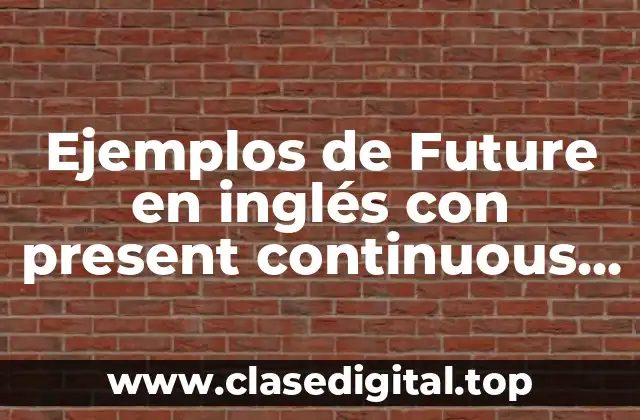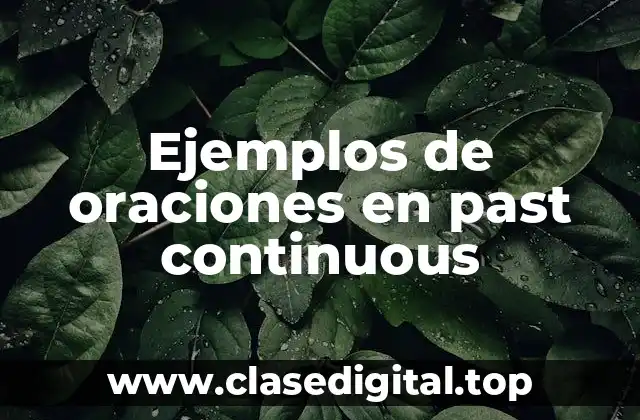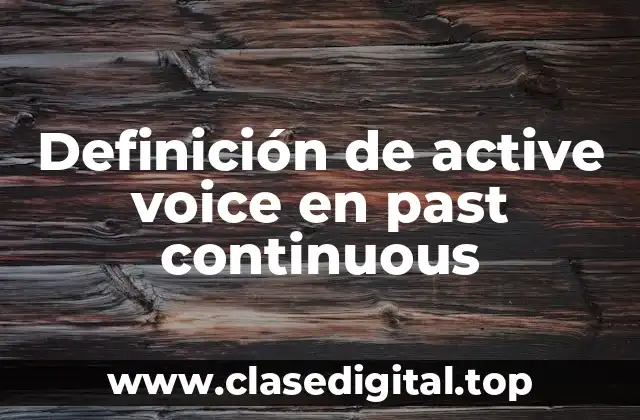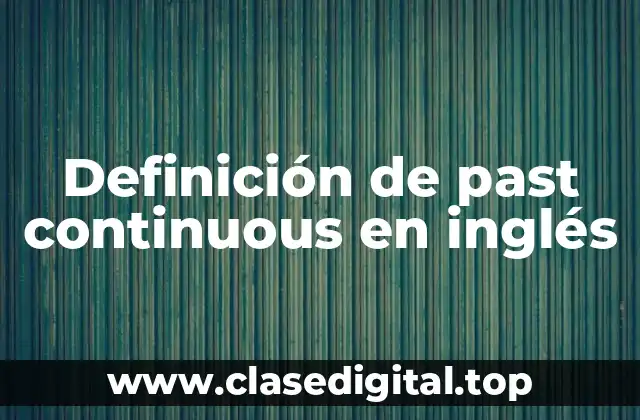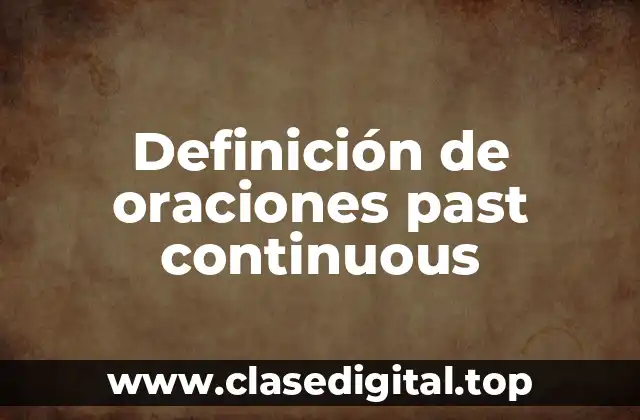El futuro perfecto continuo es una forma verbo que se utiliza para describir una acción que comenzará en un momento específico en el futuro y continuará hasta un momento futuro determinado. En este artículo, exploraremos los conceptos y ejemplos de Future Perfect Continuous.
¿Qué es Future Perfect Continuous?
El Future Perfect Continuous se forma con el verbo to be en el futuro perfecto (will have been) más el verbo principal en su forma inglesa -ing. Esta forma verbo es utilizada para describir una acción que comenzará en el futuro y continuará hasta un momento futuro determinado.
Ejemplos de Future Perfect Continuous
Ejemplo 1: By next year, I will have been studying English for five years. (Próximamente, habré estudiado inglés durante cinco años.)
Ejemplo 2: By the time I graduate, I will have been working on this project for three months. (Al momento en que me gradúo, habré estado trabajando en este proyecto durante tres meses.)
Ejemplo 3: By the end of the month, I will have been practicing yoga for six months. (Al final del mes, habré estado practicando yoga durante seis meses.)
Ejemplo 4: By the time I retire, I will have been teaching for 30 years. (Al momento en que me jubile, habré estado enseñando durante 30 años.)
Ejemplo 5: By next summer, I will have been traveling for three years. (Próximamente, habré estado viajando durante tres años.)
Ejemplo 6: By the end of the year, I will have been living in this city for five years. (Al final del año, habré estado viviendo en esta ciudad durante cinco años.)
Ejemplo 7: By the time I turn 30, I will have been working for 10 years. (Al momento en que tenga 30 años, habré estado trabajando durante 10 años.)
Ejemplo 8: By the end of the project, I will have been working on it for six months. (Al final del proyecto, habré estado trabajando en él durante seis meses.)
Ejemplo 9: By next Christmas, I will have been married for five years. (Próximamente, habré estado casado durante cinco años.)
Ejemplo 10: By the end of the semester, I will have been attending classes for four years. (Al final del semestre, habré estado asistiendo a clases durante cuatro años.)
Diferencia entre Future Perfect Continuous y Future Perfect Simple
Uno de los principales problemas que los estudiantes de inglés tienen es la diferencia entre Future Perfect Continuous y Future Perfect Simple. La principal diferencia es que el Future Perfect Continuous se utiliza para describir una acción que comenzará en el futuro y continuará hasta un momento futuro determinado, mientras que el Future Perfect Simple se utiliza para describir una acción que comenzará en el futuro y terminará antes de un momento futuro determinado.
¿Cómo se puede utilizar Future Perfect Continuous en una oración?
Future Perfect Continuous se utiliza para describir una acción que comenzará en el futuro y continuará hasta un momento futuro determinado. Por ejemplo: By next year, I will have been studying English for five years (Próximamente, habré estudiado inglés durante cinco años).
¿Cuáles son los usos del Future Perfect Continuous?
El Future Perfect Continuous se utiliza en una variedad de situaciones, como describir una acción que comenzará en el futuro y continuará hasta un momento futuro determinado, como en: By next summer, I will have been traveling for three years (Próximamente, habré estado viajando durante tres años).
¿Cuándo se utiliza Future Perfect Continuous?
El Future Perfect Continuous se utiliza cuando se describe una acción que comenzará en el futuro y continuará hasta un momento futuro determinado. Por ejemplo: By the time I graduate, I will have been working on this project for three months (Al momento en que me gradúo, habré estado trabajando en este proyecto durante tres meses).
¿Qué son los efectos del Future Perfect Continuous en una oración?
El Future Perfect Continuous puede tener un efecto emocional en la oración, como en: By next year, I will have been studying English for five years, and I will feel proud of myself (Próximamente, habré estudiado inglés durante cinco años, y sentiré orgullo de mí mismo).
Ejemplo de Future Perfect Continuous en la vida cotidiana
Ejemplo: By next spring, I will have been working on this project for a year, and I will have a good understanding of the subject (Próximamente, habré estado trabajando en este proyecto durante un año, y tendré una buena comprensión del tema).
Ejemplo de Future Perfect Continuous desde otra perspectiva
Ejemplo: By the time I have children, I will have been working in this company for 10 years (Al momento en que tenga hijos, habré estado trabajando en esta empresa durante 10 años).
¿Qué significa Future Perfect Continuous?
El Future Perfect Continuous significa que una acción comenzará en el futuro y continuará hasta un momento futuro determinado. Por ejemplo: By next year, I will have been studying English for five years (Próximamente, habré estudiado inglés durante cinco años).
¿Cuál es la importancia de Future Perfect Continuous en la comunicación?
La importancia del Future Perfect Continuous en la comunicación es que permite describir una acción que comenzará en el futuro y continuará hasta un momento futuro determinado, lo que puede ser útil en situaciones como describir planes, expectativas y metas.
¿Qué función tiene Future Perfect Continuous en una oración?
La función del Future Perfect Continuous es describir una acción que comenzará en el futuro y continuará hasta un momento futuro determinado. Por ejemplo: By next summer, I will have been traveling for three years (Próximamente, habré estado viajando durante tres años).
¿Cómo Future Perfect Continuous se relaciona con el pasado?
El Future Perfect Continuous se relaciona con el pasado en la medida en que describe una acción que comenzará en el futuro y continuará hasta un momento futuro determinado, lo que puede tener un efecto en el pasado.
¿Origen de Future Perfect Continuous?
El Future Perfect Continuous tiene su origen en la gramática inglesa, y se formó a partir de la combinación de los verbos to be y to have con el verbo principal en su forma inglesa -ing.
¿Características de Future Perfect Continuous?
Las características del Future Perfect Continuous son que se utiliza para describir una acción que comenzará en el futuro y continuará hasta un momento futuro determinado, y se forma con el verbo to be en el futuro perfecto (will have been) más el verbo principal en su forma inglesa -ing.
¿Existen diferentes tipos de Future Perfect Continuous?
Sí, existen diferentes tipos de Future Perfect Continuous, como el futuro perfecto continuo simple y el futuro perfecto continuo compuesto.
A que se refiere el término Future Perfect Continuous y cómo se debe usar en una oración
El término Future Perfect Continuous se refiere a una forma verbo que se utiliza para describir una acción que comenzará en el futuro y continuará hasta un momento futuro determinado. Se debe usar en una oración para describir una acción que comenzará en el futuro y continuará hasta un momento futuro determinado.
Ventajas y desventajas de Future Perfect Continuous
Ventajas: el Future Perfect Continuous es útil para describir planes, expectativas y metas; permite describir una acción que comenzará en el futuro y continuará hasta un momento futuro determinado.
Desventajas: el Future Perfect Continuous puede ser confuso para los estudiantes de inglés; puede ser difícil de usar correctamente en una oración.
Bibliografía de Future Perfect Continuous
- The Oxford English Grammar de Sidney Greenbaum
- The Cambridge Grammar of the English Language de Rodney Huddleston y Geoffrey Pullum
- The Longman Grammar of Spoken and Written English de Douglas Biber, Susan Conrad y Geoffrey Leech
- The Routledge Dictionary of English Language and Linguistics de Ronald Carter y Malcolm Todd
Miguel es un entrenador de perros certificado y conductista animal. Se especializa en el refuerzo positivo y en solucionar problemas de comportamiento comunes, ayudando a los dueños a construir un vínculo más fuerte con sus mascotas.
INDICE


